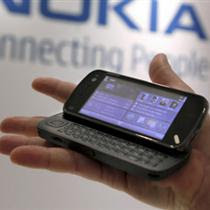HELSINKI - The world's top mobile phone maker Nokia plans to tap the surging market for connecting laptops to wireless networks taking on market leader Huawei Technologies, its senior official said.
A Nokia N97 is
demonstrated at the Nokia Capital Markets
Day in New York, December 4, 2008.
Nokia will start to ship its first Internet stick in early 2009, aiming to benefit from its know-how and experience in developing 3G technologies, Tapio Markki, vice president for hardware platform components at Nokia, told Reuters.
"Leveraging these capabilities, we believe we are well-positioned to become one of the winning providers for HSPA modem solutions. The market for HSPA modems is expected to grow very rapidly during the coming years," Markki said.
Nokia declined to comment on the price of the device -- which uses HSPA, a super-fast 3G technology -- saying it would be sold mostly through operators and bundled with services.
Strategy Analytics said it expects the global market for so-called "dongles" -- external USB modems and PC cards -- to grow to 26 million units next year from 20 million this year.
"In particular European operators, such as Vodafone, are aggressively promoting and subsidizing dongles right now, because they are seen as a secondary device that provides additional revenues for carriers beyond a traditional handset," said Neil Mawston from Strategy Analytics.
Nokia tried to enter into the business of connecting laptops to wireless networks in late 2006 when it said it had developed an embedded 3G module for notebook computers, which Intel agreed to sell as part of its next-generation Centrino Duo mobile technology platform.
But in early 2007, Nokia and Intel made a joint decision to cease cooperation on the connectivity module.

0 comments:
Post a Comment